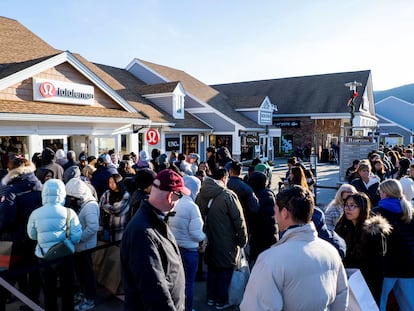Tiffany Wilding (Pimco): ‘There is a risk of recession in the US and it is being underpriced’
The economist and managing director at the fixed income investment giant compares the probability of a crisis to a coin flip


Tiffany Wilding is the top expert on the U.S. economy at Pimco, the fixed income investment giant. This expert highlights as the great surprise of the year the enormous resilience of the world’s leading economy. Numerous forecasts had pointed to a recession that never materialized. According to Wilding, it is still early to claim victory and assert that a soft landing has been achieved, that is, a reduction in inflation without a recession. She sees an approximately 50% chance of recession, like flipping heads or tails with a coin, and believes that the market is underestimating that risk.
Wilding thinks that the risk of a slowdown in 2024 remains high because the savings buffers that have supported demand so far should soon return to pre-pandemic levels; also, fiscal policy will likely be slightly contractionary and the effects of rate increases will be felt. Additionally, central bankers have said they plan to keep rates high for an extended period of time, which runs counter to the loosening of monetary policy that has historically contributed to soft landings.
The economist, who answered by videoconference from Newport Beach (California), believes that a key question for 2024 may be whether central banks will declare victory and begin to cut rates preemptively, but she notes that historical precedents are not favorable. Central banks do not typically anticipate economic weakness early enough to preemptively cut rates to avoid a recession, but have tended to begin doing so coinciding with rising unemployment rates and economic contraction.
Prior to joining Pimco in 2016, where she holds managing director status, Wilding was head of global interest rate research at Tudor Investment, where she was responsible for recommending trade ideas based on global macroeconomic trends. Previously, she was a vice president for U.S. interest rate research with Morgan Stanley and a Treasury market policy analyst for the Federal Reserve Bank of New York, where she helped structure and implement the central bank’s response to the 2008 financial crisis. She has 16 years of experience in investments and economic/financial markets and holds an MBA in quantitative finance from the Stern School of Business at New York University. She obtained her undergraduate degree from Rhodes College.
Question. What would you highlight about the evolution of the United States economy this year?
Answer. The key surprise this year was just the resilience of the U.S. economy and of growth in particular, despite the fact that we’ve had the most aggressive central bank response to elevated inflation in decades, Europe had a material energy shock and the U.S. itself had a small scale banking crisis in March. Despite all this, the United States economy has managed to grow around 2.5% for the full year.
Q. And why has it been like this?
A. We must take a step back and take stock of why this has been the case and see what may have contributed to that surprising growth. We did a lot of analysis around that. And the conclusion we reached, basically, is that the United States’ fiscal response to the pandemic was much greater than in other developed countries. That surplus has reached households in the form of liquid assets and has been a much larger buffer than anyone anticipated it would be for broader growth. There have also been improvements on the labor supply side due to immigration and the participation rate, which have allowed this additional demand to be absorbed and inflation to moderate this year. These positive pandemic surpluses have supported growth this year, but they are fading. There’s some uncertainty about when exactly they’ll fade away, but we’re closer than we were at the beginning of this year. And when those balances are normalized, what we are really left with is tight monetary policy. Markets have priced in much of this growth and resilience story, but we believe they are being complacent in the face of recession risks.
Q. Fiscal policy continues to be expansive, with a skyrocketing deficit and debt.
A. Part of the widening of the deficit that we have seen has been the result of one-off factors such as delays in tax collection due to natural disasters and also adjustments for the cancellation of student loans that the Supreme Court annulled, so there has been a lot of noise with the deficit figures. Some of it is due to automatic stabilizers and the drop in capital gains tax revenue after the 2022 market crash, it has not been a problem of increased spending. We have a better year with capital gains in 2023, but for the future there is uncertainty about the degree to which the effects of the tax credits of the Inflation Reduction Act, the Bipartisan Infrastructure Law or the CHIPS act will be incorporated and on how they will negatively impact the deficit.
Q. Have official interest rates peaked?
A. The most likely scenario, the base case, is that the Federal Reserve has already finished its job of raising rates. It is true that in their own September projections they pointed to a rise of more than 0.25 points for this year, but I think that at the last FOMC [monetary policy committee] meeting, Chairman Jay Powell was reasonably clear that this was not likely to happen in December. Whether or not there are more rate hikes in the future will depend on how the economy is performing and whether we really have the slowdown in growth that everyone expects. Because if it doesn’t, and consumption continues to grow at a really robust 2.5%-3% pace, I could see the Fed hiking rates again. But if what we expect happens, that the economy slows down for various reasons, including tight monetary policy and in tighter financial conditions, then I don’t think they will raise them again. I think instead there will be a sort of prolonged period on hold until they finally start cutting rates. And I predict that they will not go down until they are confident that inflation is reduced to 2%, which will require lower growth and an increase in the unemployment rate.
Q. How likely is the soft landing scenario versus the risk of a recession?
A. We have worked a lot on historical precedents. In developed markets, we have found 140 cycles of rate hikes in the last 70 years, and in cases where inflation at the beginning of a cycle was as high as this time and the central bank raised more than four percentage points, the rates to combat it, 90% of those rate hike cycles ended in recession. So just from that historical experience, without knowing anything else, we think it’s reasonable to say that we are in a moment where there is a higher than normal probability of recession. Where would we put that probability? We believe it is reasonable to say that in the case of the United States it is like flipping a coin, the odds are very even. If you look at the rate hike cycles where there was a soft landing, they occurred when there was some kind of positive economic supply shock that coincided with the rate hike cycle. For example, the productivity boom in the 90s; trade expansion in the 60s; OPEC’s oil supply increase in the mid-1980s. There was a sort of positive supply shock, which allowed inflation to drop quickly after the central bank started raising rates, and then they didn’t hike as aggressively and they even cut more aggressively. Following that reasoning, now the question on the supply side is whether we are getting some normalization of supply since the pandemic. But it’s not clear that that will be enough to allow central banks to feel comfortable cutting rates somewhat aggressively next year. Basically, their message is that we are going to have high rates for longer. And if that holds true, as our view would be, that is historically very consistent with the possibility of a recession coming at some point. The risks of recession are not fully priced in the markets, which are being a bit complacent about it. We continue to believe that there are risks of recession and that they are being underpriced.
Q. Over the last year, it has constantly been said that the recession was coming, but it never comes.
A. Well, it remains to be seen. Just because it hasn’t arrived yet doesn’t mean it will never come. There are good reasons to think that this time the lag in the effects of monetary policy has been a little longer due to excess savings and other causes related to the pandemic. But that doesn’t necessarily suggest we’re out of the woods yet. I mean, it’s certainly possible that we won’t have a recession, we think it’s closer to a coin flip, and we just think the markets are not pricing that in.
Sign up for our weekly newsletter to get more English-language news coverage from EL PAÍS USA Edition
Tu suscripción se está usando en otro dispositivo
¿Quieres añadir otro usuario a tu suscripción?
Si continúas leyendo en este dispositivo, no se podrá leer en el otro.
FlechaTu suscripción se está usando en otro dispositivo y solo puedes acceder a EL PAÍS desde un dispositivo a la vez.
Si quieres compartir tu cuenta, cambia tu suscripción a la modalidad Premium, así podrás añadir otro usuario. Cada uno accederá con su propia cuenta de email, lo que os permitirá personalizar vuestra experiencia en EL PAÍS.
¿Tienes una suscripción de empresa? Accede aquí para contratar más cuentas.
En el caso de no saber quién está usando tu cuenta, te recomendamos cambiar tu contraseña aquí.
Si decides continuar compartiendo tu cuenta, este mensaje se mostrará en tu dispositivo y en el de la otra persona que está usando tu cuenta de forma indefinida, afectando a tu experiencia de lectura. Puedes consultar aquí los términos y condiciones de la suscripción digital.
More information
Últimas noticias
Most viewed
- Sinaloa Cartel war is taking its toll on Los Chapitos
- Oona Chaplin: ‘I told James Cameron that I was living in a treehouse and starting a permaculture project with a friend’
- Reinhard Genzel, Nobel laureate in physics: ‘One-minute videos will never give you the truth’
- Why the price of coffee has skyrocketed: from Brazilian plantations to specialty coffee houses
- Silver prices are going crazy: This is what’s fueling the rally










































